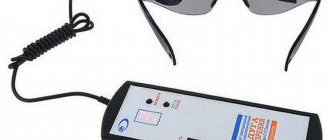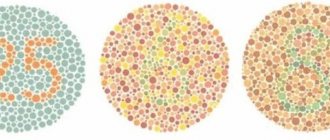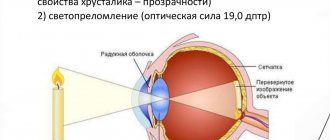Corneal thickness and laser vision correction:
First, let's understand the theory - any method of laser vision correction is based on the fact that part of the cornea is evaporated with a laser, thus creating a lens of the required optical power inside it and vision becomes ideal.
As you probably already understood, since part of the cornea is evaporated, the cornea becomes even thinner than it was originally, this imposes restrictions related to the thickness of the cornea, because the thinner your cornea is initially, the less it will be possible to “remove” with a laser without danger to health.
At the moment, there are generally accepted numbers that are considered safe:
- of at least 300 microns should remain
- The evaporated part of the cornea should be no more than 40%
of the original thickness of the cornea
Now let’s figure out how to calculate whether you fit these numbers or not. The most important thing you need to know for calculations is that to create a lens in your eye of -1 diopter,
you need to evaporate approximately
15 microns of the cornea
. Thus, the more negative your vision is, the more cornea you need to evaporate, for example, if you have -5 vision, then you will need to evaporate 5 * 15 = 75 microns of the cornea.
Also, if you have astigmatism, then it is also added to the calculation, for example, if you have -5 vision, and also have -2 astigmatism, then you already need to evaporate approximately (5+2) * 15 = 105 microns of the cornea.
In general, I think you have already understood that the greater your vision deficiency, the more cornea you will have to evaporate with a laser in order to achieve ideal vision, so if your disadvantage is small, then you can usually do laser vision correction even with a thin cornea, i.e. .To. and you will need to remove very little, but if you have a big disadvantage and, moreover, a thin cornea, then laser correction will most likely not be possible or you will have to make some compromises, which I will also talk about below.
Before moving on to specific examples, let’s consider what thickness of the cornea is generally considered thin:
- More than 520 microns
is the normal thickness of the cornea, most likely you will be able to do any type of correction. - From 500 to 520 microns
- a relatively thin cornea. In most cases, any type of correction can be done, but not always. - From 480 to 500 microns
- a thin cornea; not all types of correction are suitable for you and in rare cases correction will be impossible. - From 460 to 480 microns
- a very thin cornea; only certain types of correction will suit you; in some cases, correction will be impossible. - Less than 460 microns
is an extremely thin cornea, which may also indicate that you have corneal diseases. Correction is often impossible. Here you need to find out everything from the doctor after a full examination.
Now let's look at more correct examples of what corneal thickness is needed for each vision correction method.
Chief ophthalmologist of St. Petersburg: “Laser vision correction can be done. But is it necessary?
— Yuri Sergeevich, now myopia can be corrected in just a couple of minutes with the help of laser vision correction. However, any operation is still a risk. In what cases should vision correction be done, and when is it better to avoid it?
“Patients often come to me with one question: “Can I have laser correction?” I answer: “It’s possible, but is it necessary?” There are clear medical indications for laser vision correction. Let's say the difference in the refractions of two eyes. For example, in one eye there is little myopia, and in the other there is great myopia. Glasses will not help here, because people cannot tolerate a difference in glasses of more than 2-2.5 diopters. It happens that a person needs good vision without glasses due to the nature of his work. Military personnel, athletes, and stars may encounter this. But most people who come to us are ready to undergo surgery simply for cosmetic reasons. St. Petersburg residents come to me with slight myopia of two or three diopters. They say, "Give us surgery because we don't want to wear glasses or bother with contact lenses."
(Find out how to cure cataracts without going broke here)
But any operation, including laser vision correction, is still a risk. Complications are possible. Patients need to be told about this and warned. It is impossible for laser vision correction to be performed by a doctor who is driven largely by commercial interests. The state bought us all the necessary expensive equipment. And we do not need, as they say now, to beat back the cost of the laser. Therefore, we frankly explain the possible consequences of the operation. To give permission for laser correction, the doctor must be sure that the patient’s myopia has not progressed over the past two years. Otherwise, some time after the operation, vision may decrease again.
Women should remember that myopia can progress during pregnancy. The fact is that during this period of life the properties of the connective tissue change, and the eye may stretch a little along its axis. So, if possible, it is better to do the correction after childbirth. In addition, the possibility of surgery depends on the anatomical features of the eye. For example, correction cannot be done if the cornea is very thin. After all, during the operation, the uppermost part of the cornea is cut off and folded to the side, like a piece of paper. Then a part of the cornea is evaporated, after which this flap is placed in place. I was told a case when a patient, after an operation, rubbed his eyes with his hands. And he rolled the corneal flaps into a tube... In this regard, one can recall the words of eye microsurgeon Svyatoslav Fedorov: the patient’s irresponsible attitude towards his health is a contraindication to surgery. And this is absolutely correct.
— Even after laser correction, vision can deteriorate again. Is it permissible to perform the operation again in this case?
- It’s possible. But here it is important to remember that it is also impossible to thin the cornea too much. In this case, it can take a cone-shaped shape and protrude under the influence of intraocular pressure. And very serious problems will arise. For the same reason, vision correction is not performed for people with a high degree of myopia.
— If the operation was successful, could any complications arise in 20-30 years?
“This is unlikely if the laser correction was done correctly, and the patient subsequently monitored his health. Some problems arose only in those who underwent keratotomy using the Fedorov method. By the way, they are no longer held now. And all because this operation involves an incision in the cornea of the eye. This dramatically reduces its strength. Even with minimal trauma, such as being hit by a ball, numerous cases of corneal rupture have occurred in humans.
— But if laser correction is safe, why do many doctors wear glasses themselves?
— Probably because ophthalmologists, by virtue of their profession, work with various optical magnifying devices. Therefore, the issue of defective vision is resolved very simply: you just need to configure the equipment accordingly.
— Suppose a person refuses laser correction. And he is faced with a choice - glasses or contact lenses . Which is safer?
— Contact lenses are a very good means of vision correction. But they need to be constantly processed, they need to be changed on time. If a person is not ready for this, then it is better to choose glasses. By the way, I would not recommend buying lenses in online stores, or buying glasses in kiosks.
— If lenses are safe, then why do doctors require them to be removed 3-4 months before laser vision correction?
— Lenses still have an effect on the eyes. On the one hand, they slightly deform the cornea. It's OK. But before surgery, this may lead to the doctor incorrectly determining the parameters of the cornea. On the other hand, incorrectly selected lenses can disrupt the nutrition of the cornea and impede the penetration of oxygen into it. This can then have a negative impact on the healing process after surgery.
(Where to treat eye diseases in St. Petersburg, read here)
Katerina Kuznetsova, “MK in St. Petersburg”
Corneal thickness for ReLEx Smile:
At the moment, the ReLEx Smile technology is the newest and is considered the most gentle on the eye, but it is not suitable for everyone; the fact is that for this technology, during the operation, the laser goes deep into the cornea by about 130 microns and begins to evaporate the lens only there (at middle of the cornea), so from your initial corneal thickness you need to immediately subtract 130 microns, which will go to this “deepening” and count from there.
Example:
The thickness of the cornea is 500 microns, visual acuity is -3. During the ReLEx Smile operation, the residual thickness of the cornea will be 500 - 130 - 3*15 = 325 microns
As you can see in this example, the residual thickness of the cornea was 325 microns, which meets the first criterion (that the residual thickness of the cornea should be more than 300 microns).
As for the second criterion, let's calculate (130 + 3*15)/500 = 35%, respectively, during the operation 35% of your cornea was removed, which “butt” fits the second criterion (that the evaporated part of the cornea should be no more than 35% of initial.)
Thus, as you can see, with the data indicated at the beginning of the example, correction can theoretically be carried out, but one of the safety criteria is already “imperfect”, so perhaps the doctor will suggest another safer method of correction in this case.
The minimum corneal thickness for ReLEx Smile is approximately 500 microns
due to the fact that a fairly “thick” cap of 130 microns is required.
There is a short video regarding ReLEx Smile and thin corneas:
Corneal thickness for Femto Lasik:
At the moment, Femto Lasik is a fairly new technology that allows you to make a very thin cap, making Femto Lasik surgery possible even with very thin corneas.
The thinnest valve that is usually made with Femto Lasik is 90 microns. As you can see, this is 40 microns less than in the previous method, respectively, which leaves 40 microns more for evaporating the lens (and 40 microns is almost 3 diopters).
I will not repeat all the calculations again, I think you can already calculate everything yourself, I will only note that, as I already wrote above, an additional 40 saved microns of the cornea will allow you to remove 3 diopters more than the ReLEx Smile method with the same initial corneal thickness.
The minimum corneal thickness for Femto Lasik is approximately 470 microns
due to the thinnest cap of 90 microns.
For more information about Femto Lasik for thin corneas, watch the video:
Advantages of laser correction for myopia
Continuing our conversation about the need to use laser correction to treat myopia, it would be advisable to talk about the advantages of this procedure. Laser correction has the following advantages:
- Safety. Long-term observations of patients have shown that this type of treatment is absolutely safe and very effective.
- Possibility of use for various eye diseases. If patients have no contraindications, laser treatment will help restore good vision for many eye ailments.
- Speed of the operation. The duration of the procedure is no more than 20 minutes.
- Painless. Thanks to anesthetic eye drops that completely block pain, the patient only feels touch during the procedure.
- Stable results. Provided the patient does not have progressive myopia, the correct shape of the cornea after laser correction will remain for many years.
Corneal thickness for Lasik:
Conventional Lasik uses microkeratomas to form the valve, which are usually less accurate compared to the Femto laser, and accordingly with conventional Lasik the cap is thicker - approximately 130 microns, you also need to take into account the inaccuracy of conventional blades - they can give an error of 10-20 microns, so in the end the cap may turn out to be not 130, but as much as 150 microns.
Thus, regular Lasik is suitable only for those who have a completely normal corneal thickness.
The minimum corneal thickness for Lasik is approximately 520 microns.
Corneal thickness for PRK (LasEk):
PRK is the oldest method of vision correction, which has many disadvantages and which people now try not to use unless necessary, but PRK has a big plus - it can be used to correct vision even on the thinnest corneas.
The removed top layer of the cornea with PRK is only 40-60 microns, which is significantly less than with any other laser correction method, so PRK can be done on thin corneas for which no other correction method is suitable.
The minimum corneal thickness for PRK is approximately 450 microns.
Types of eye surgeries
For myopia, various types of eye surgeries are prescribed. The main method of restoring vision for myopia is called laser vision correction. There are various methods of correcting myopia surgically, the leading places among which are occupied by two types of laser treatment: photorefractive keratectomy (PRK) and laser keratomileusis (LASIK). However, for some types of myopia and its accompanying diseases, other types of intervention are required, including:
- scleroplasty,
- removal or replacement of the eye lens,
- radial keratotomy.
All operations are prescribed by an ophthalmologist after a comprehensive examination of the patient to identify indications and contraindications. Prices for eye surgery for myopia depend on the region of the country and the chosen clinic.
Laser correction of myopia
The most common operation for uncomplicated myopia is laser vision correction. A high-precision excimer laser reshapes the cornea of the eye so that its refractive properties become normal and the image of distant objects is projected accurately onto the retina, providing clear vision. In the absence of contraindications to laser surgery, this is the best way to regain one hundred percent vision.
See the laser correction technology in the video:
Such operations to correct vision are classified as cosmetic, they are quick and painless, the postoperative period is easy, and the effect is stable. Minimal risk and excellent predictability make this method even more attractive. The price of the operation is from 30,000 to 50,000 rubles per eye. Let's consider two leading methods of laser vision correction: PRK and LASIK.
Photorefractive keratectomy (PRK)
This method involves the laser working directly with the surface of the cornea of the eye. The laser beam evaporates part of the layer of corneal tissue so as to change its curvature as needed. All calculations are carried out using a computer; the laser exactly carries out the individual program embedded in the device for each patient.
Before the intervention, the eyes are anesthetized by instilling drops of anesthetic, so pain is excluded. The eye is fixed using a special dilator, since you cannot blink during the operation. The patient looks at the indicated point, while the surgeon relieves him of myopia. The process usually takes no more than 10-15 minutes.
The disadvantage of this operation is the limitation on the degree of myopia: PRK is not performed for myopia of more than 6 diopters. If vision is below this value, then LASIK will help if there are no contraindications.
Laser assisted keratomileusis (LASIK)
Laser keratomileusis has proven itself as an effective and safe method for correcting myopia, which allows you to restore sharp vision even with significant degrees of myopia. However, for the operation to be carried out, it should not progress by more than one diopter per year.
Laser treatment with LASIK is technically different from PRK in that the middle layer of the cornea is used for correction. To access it, a special valve is cut out on the surface of the eye in the upper layer of tissue, which the surgeon bends to the side before performing refractive error correction. Then, with the help of a laser, the refractive power of the cornea is changed, and the eye gains the ability to clearly see objects at long distances.
Laser keratomileusis allows you to get rid of myopia down to -15 diopters.
Lens removal and replacement
Lens replacement for myopia is not prescribed very often. It is used if there are contraindications to laser vision correction. With a high degree of myopia, more than 15 diopters, when laser treatment is unacceptable, lens replacement becomes the only way to achieve normal vision.
During the operation, the doctor provides access to the lens through a narrow channel by puncturing the tissue, then the natural lens is destroyed and removed from the eye. The second stage of the intervention is the implantation of a prosthesis into the eye - an artificial lens, which will provide the patient with normal visual acuity. This operation lasts on average from 20 to 40 minutes.
Lens replacement is carried out not only for severe myopia, but also for cataracts - clouding of the natural inner lens of the eye.
In the Russian Federation, cataract treatment is possible under compulsory medical insurance within the framework of a quota. During the operation, a Russian-made artificial lens is used for implantation free of charge. The cost of an imported lens will be 10,000-20,000 rubles. A paid operation will cost the patient 45,000-100,000 rubles.
Scleroplasty
As myopia progresses, patients are often prescribed a microsurgical operation such as scleroplasty. The intervention is aimed at strengthening the sclera of the eye in order to stop or at least slow down the decline in vision. Scleroplasty is often prescribed to children and adolescents whose vision is rapidly deteriorating due to the continued growth of the eyeball and high visual loads.
During the operation, the doctor inserts a special scleroplastic material behind the back wall of the eye. This prevents further growth of the eye in length and improves blood supply. Such an intervention does not improve vision, it only helps to stop its deterioration until the moment when excimer laser correction becomes possible.
On average, the price for scleroplasty varies from 8,000 to 15,000 rubles per eye.
Anterior radial keratotomy
This type of operation is not used for high myopia; it is more often prescribed for small or moderate myopia, including those combined with pathology such as astigmatism. In essence, the method resembles PRK, but is performed not with a laser, but with a special scalpel manually. After anesthetizing the eye, the doctor applies a special marking to the cornea and makes radial incisions on its surface. After surgery, the surface of the eye changes curvature as a result of natural tissue healing.
Due to the lower predictability and long rehabilitation period compared to photorefractive keratectomy, doctors are increasingly abandoning anterior radial keratotomy in favor of PRK.
The cost of radial keratotomy is 10,000-35,000 rubles.
Reduced treatment area for thin corneas:
Another option if you have a thin cornea is to reduce the laser treatment area.
This option is suitable for those who are slightly lacking in corneal thickness to meet safe numbers for correction. With a reduced exposure area to remove -1 diopter
only about
12 microns
instead of 15.
True, there are also disadvantages to this method - they roughly say that the lens that the laser makes in your eye will be smaller in diameter than the standard one, and this leads to a deterioration in the quality of vision in the dark when your pupil dilates. Due to the dilation of the pupil, it can become larger than this lens and many unpleasant optical effects will appear in the dark.
In any case, if such a correction option is possible, they will most likely offer it to you and tell you about all the possible side effects.
Incomplete correction for thin corneas:
And the last correction option for thin corneas, which I would like to discuss in this article, is incomplete correction.
I think the essence is clear from its name - they do not give you perfect vision, but leave a small minus (usually from -1.5 to -0.5 diopters). Actually, this option can also be considered if your cornea is very thin and there is no way to make a complete correction, because you must admit that vision is -1.5, after say -8, this is a huge difference. At -1.5, you will most likely be able to do without glasses in everyday life and generally have good vision.
Again, if such a correction option is possible, they will most likely offer it to you and tell you about all the possible side effects.
What kind of bus is going in the distance? Was it a familiar person passing by or just an illusion? What does an actor look like on the theater stage from the 10th row? Every person, even with slight visual impairment, has asked such questions at least once. To correct vision, many people choose glasses or contact lenses. How much do they cost to the budget?
How much do lenses cost?
The cost of lenses varies greatly depending on the brand, type of wear, and a person’s vision characteristics. On average, daily contact lenses cost from 1,200 rubles per pack. If there are 30 pieces or 15 pairs in a box, you will need exactly two of them for a month, which is 2,400 rubles or 28,800 rubles per year.
A more economical option is lenses that can be worn for two weeks. They cost 1,300 rubles per package, enough for a month and a half. In total, such lenses will cost from 10,400 rubles per year. But that is not all. When you make your first purchase, you will need to fork out for containers - up to 100 rubles, tweezers - up to 100 rubles, moisturizing drops (sometimes lenses dry out your eyes) - from 300 to 600 rubles per pack; about three packs will be needed per year. You will also need a solution for treating and cleaning lenses. The cost varies depending on the volume - from 100 to 800 rubles. Many people prefer to buy large bottles at once, which last for three months. This means that to the annual cost of two-week lenses you need to add consumables from 2,600 rubles. If you add this amount to the cost of the lenses, it will be about 13,000 rubles per year.
Is it better to wear glasses?
Someone will say: but you can use glasses. That's right, this option is also worth calculating. There are now a huge number of options for models, colors and formats. The situation with prices is the same, but on average, a decent frame can be found from 3,000 rubles. A vision test will be added to the amount - from 500 rubles, the cost of lenses from 1000 rubles for each eye, as well as the work of a specialist - about 1500 rubles. Total: from 7,000 rubles. Good glasses, with proper care and proper wear, will last two to three years at best. And then it is unknown whether the price will change, whether the necessary frame or model will be found. However, no one can guarantee that the glasses will not break before this time.
Investment in health for many years
And finally, the third option for possible vision correction is surgery. At the Arkhangelsk Ophthalmological Laser Clinic it will cost 36,000 rubles for both eyes. Any surgical intervention requires consultation with a specialist, so you need to budget 1,800 rubles for an appointment with an ophthalmologist. Additional correction of LASIK or PRK (depending on indications) within 18 months after the first operation at OLK LLC is free. All together: 37,800 rubles - the cost of investing in vision, which you will never have to spend money on again.











